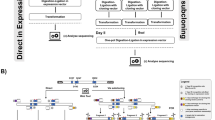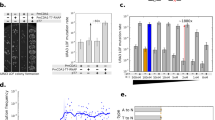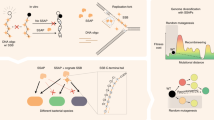Abstract
We have developed a simple and efficient method for in vitro mutagenesis and recombination of polynu-cleotide sequences. The staggered extension process (StEP) consists of priming the template sequence(s) followed by repeated cycles of denaturation and extremely abbreviated annealing/polymerase-catalyzed extension. In each cycle the growing fragments anneal to different templates based on sequence complementarity and extend further. This is repeated until full-length sequences form. Due to template switching, most of the polynucleotides contain sequence information from different parental sequences. The method is demonstrated by the recombination of two genes encoding thermostable subtilisins carrying two phenotypic markers separated by 113 base pairs and eight other point mutation markers. To demonstrate its utility for directed evolution, we have used StEP to recombine a set of five thermostabilized subtilisin E variants identified during a single round of error-prone PCR mutagenesis and screening. Screening the StEP-recombined library yielded an enzyme whose half-life at 65°C is 50 times that of wild-type subtilisin E.
This is a preview of subscription content, access via your institution
Access options
Subscribe to this journal
Receive 12 print issues and online access
$209.00 per year
only $17.42 per issue
Buy this article
- Purchase on Springer Link
- Instant access to full article PDF
Prices may be subject to local taxes which are calculated during checkout
Similar content being viewed by others
References
Stahl, F.W. 1987. Genetic recombination. Sci. Am. 256: 1–101.
Kucherlapati, R. and Smith, G.R. 1988. Genetic recombination. American Society of Microbiology, Washington, DC.
Holland, J.H. 1992. Genetic algorithms. Sci. Am. 267: 66–72.
Holland, J.H. 1992. Adaptation in natural and artificial systems. 2nd ed. MIT Press, Cambridge, MA,
Forrest, S. 1993. Genetic algorithms: Principles of natural selection applied to computation. Science 261: 872–878.
Kuchner, O. and Arnold, F.H. 1997. Directed evolution of enzyme catalysts. Trends Biotech. 15: 523–530.
Stemmer, W.P.C. 1994. Rapid evolution of a protein in vitro by DNA shuffling. Nature 370: 389–391.
Stemmer, W.P.C. 1994. DNA shuffling by random fragmentation and reassembly - In vitro recombination for molecular evolution. Proc. NaU. Acad. Sci. USA 91: 10747–10751.
Zhao, H. and Arnold, F.H. 1997. Functional and nonfunctional mutations distinguished by random recombination of homologous genes. Proc. Natl. Acad. Sci. USA 94: 7997–8000.
Shao, Z., Zhao, H., Giver, L. and Arnold, F.H. 1998. Random-priming in vitro recombination: an effective tool for directed evolution. Nucl. Acids Res. 26: 681–683.
Shafikhani, S., Siegel, R.A., Ferrari, E. and Schellenberger, V. 1997. Generation of large libraries of random mutants in Bacillus subtilis by PCR-based plasmid multimerization. Biotechniques 23: 304–310.
Zhao, H. and Arnold, F.H. 1997. Optimization of DNA shuffling for high-fidelity recombination. Nucl. Acids Res. 25: 1307–1308.
Saiki, R.K., Gelfand, D.H., Stoffel, S., Scharf, S.J., Higuchi, R., Horn, G.T. et al. 1998. Primer-directed enzymatic amplification of DNA with a thermostable DNA polymerase. Science 239: 487–491.
Scharf, S.J., Friedmann, A., Brautbar, C., Szafer, F., Steinmen, L., Horn, G. et al. 1997. HLA class II allelic variation and susceptibility to pemphigus vulgaris. Proc. Natl. Acad. Sci. USA 85: 3504–3508.
Scharf, S.J., Long, C.M. and Erlich, H.A. 1998. Sequence analysis of the HLA-DRB and HLA-DQB loci from 3 pemphigus vulgaris patients. Hum. Immunol. 22: 61–69.
Bradley, R.D. and Hillis, D.M. 1997. Recombinant DNA sequences generated by PCR amplification. Mol. Biol. Evol. 14: 592–593.
Gelfand, H.A. 1989. Taq DNA polymerase, p. 18 in PCR technology. Ehrlich, H.A. (ed.). Stockton Press, New York.
Moore, J.C. and Arnold, F.H. 1996. Directed evolution of a para-nitrobenzyl esterase. Bio/Technology 14: 458–467.
Moore, J.C., Jin, H.M., Kuchner, O. and Arnold, F.H. 1997. Strategies for the in vitro evolution of protein function: enzyme evolution by random recombination of improved sequences. J. Mol Biol. 272: 336–347.
Hu, W.-S., Bowman, E.H., Delviks, K.A. and Pathak, V.K. 1997. Homologous recombination occurs in a distinct retroviral subpopulation and exhibits high negative interference. J. Virol. 71: 6028–6036.
Cadwell, R.C. and Joyce, G.F. 1994. Mutagenic PCR. PCP Methods and Applications 2: 28–33.
Author information
Authors and Affiliations
Corresponding author
Rights and permissions
About this article
Cite this article
Zhao, H., Giver, L., Shao, Z. et al. Molecular evolution by staggered extension process (StEP) in vitro recombination. Nat Biotechnol 16, 258–261 (1998). https://doi.org/10.1038/nbt0398-258
Received:
Accepted:
Issue Date:
DOI: https://doi.org/10.1038/nbt0398-258
This article is cited by
-
Efficient evolution of human antibodies from general protein language models
Nature Biotechnology (2024)
-
Improving the activity and expression level of a phthalate-degrading enzyme by a combination of mutagenesis strategies and strong promoter replacement
Environmental Science and Pollution Research (2023)
-
Glutamate indicators with improved activation kinetics and localization for imaging synaptic transmission
Nature Methods (2023)
-
Systematic molecular evolution enables robust biomolecule discovery
Nature Methods (2022)
-
ECNet is an evolutionary context-integrated deep learning framework for protein engineering
Nature Communications (2021)



